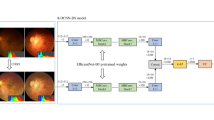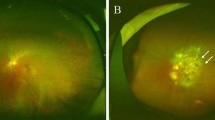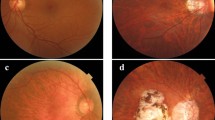Abstract
The purpose of this study was to detect the presence of retinitis pigmentosa (RP) based on color fundus photographs using a deep learning model. A total of 1670 color fundus photographs from the Taiwan inherited retinal degeneration project and National Taiwan University Hospital were acquired and preprocessed. The fundus photographs were labeled RP or normal and divided into training and validation datasets (n = 1284) and a test dataset (n = 386). Three transfer learning models based on pre-trained Inception V3, Inception Resnet V2, and Xception deep learning architectures, respectively, were developed to classify the presence of RP on fundus images. The model sensitivity, specificity, and area under the receiver operating characteristic (AUROC) curve were compared. The results from the best transfer learning model were compared with the reading results of two general ophthalmologists, one retinal specialist, and one specialist in retina and inherited retinal degenerations. A total of 935 RP and 324 normal images were used to train the models. The test dataset consisted of 193 RP and 193 normal images. Among the three transfer learning models evaluated, the Xception model had the best performance, achieving an AUROC of 96.74%. Gradient-weighted class activation mapping indicated that the contrast between the periphery and the macula on fundus photographs was an important feature in detecting RP. False-positive results were mostly obtained in cases of high myopia with highly tessellated retina, and false-negative results were mostly obtained in cases of unclear media, such as cataract, that led to a decrease in the contrast between the peripheral retina and the macula. Our model demonstrated the highest accuracy of 96.00%, which was comparable with the average results of 81.50%, of the other four ophthalmologists. Moreover, the accuracy was obtained at the same level of sensitivity (95.71%), as compared to an inherited retinal disease specialist. RP is an important disease, but its early and precise diagnosis is challenging. We developed and evaluated a transfer-learning-based model to detect RP from color fundus photographs. The results of this study validate the utility of deep learning in automating the identification of RP from fundus photographs.







Similar content being viewed by others
Abbreviations
- AI:
-
Artificial intelligence
- AMD:
-
Age-related macular degeneration
- AUROC:
-
Area under the receiver operating characteristic
- CNN:
-
Convolutional neural network
- DR:
-
Diabetic retinopathy
- grad-CAM:
-
Gradient class activation map
- IRD:
-
Inherited retinal disease
- OCT:
-
Optical coherence tomography
- ROC:
-
Receiver operating characteristic
- RP:
-
Retinitis pigmentosa
- TIP:
-
Taiwan inherited retinal degeneration project
References
Hartong DT, Berson EL, Dryja TP. Retinitis pigmentosa. Lancet. 2006; 368(9549): 1795-1809.
Prado DA, Acosta-Acero M, Maldonado RS. Gene therapy beyond luxturna: a new horizon of the treatment for inherited retinal disease. Curr Opin Ophthalmol. 2020; 31(3): 147-154.
Miraldi Utz V, Coussa RG, Antaki F, Traboulsi EI. Gene therapy for RPE65-related retinal disease. Ophthalmic Genet. 2018; 39(6): 671-677.
Ting DSW, Pasquale LR, Peng L, Campbell JP, Lee AY, Raman R, et al. Artificial intelligence and deep learning in ophthalmology. Br J Ophthalmol. 2019; 103(2): 167-175.
Gulshan V, Peng L, Coram M, Stumpe MC, Wu D, Narayanaswamy A, et al. Development and validation of a deep learning algorithm for detection of diabetic retinopathy in retinal fundus photographs. JAMA. 2016; 316(22): 2402-2410.
Lee CS, Tyring AJ, Deruyter NP, Wu Y, Rokem A, Lee AY. Deep-learning based, automated segmentation of macular edema in optical coherence tomography. Biomed Opt Express. 2017 ;8(7): 3440-3448.
Burlina PM, Joshi N, Pekala M, Pacheco KD, Freund DE, Bressler NM. Automated grading of age-related macular degeneration from color fundus images using deep convolutional neural networks. JAMA Ophthalmol. 2017; 135(11): 1170-1176.
Camino A, Wang Z, Wang J, Pennesi ME, Yang P, Huang D, et al. Deep learning for the segmentation of preserved photoreceptors on en face optical coherence tomography in two inherited retinal diseases. Biomed Opt Express. 2018; 9(7): 3092-3105.
Fujinami-Yokokawa Y, Pontikos N, Yang L, Tsunoda K, Yoshitake K, Iwata T, et al. Prediction of causative genes in inherited retinal disorders from spectral-domain optical coherence tomography utilizing deep learning techniques. J Ophthalmol. 2019; 2019: 1691064.
Kermany DS, Goldbaum M, Cai W, Valentim CC, Liang H, Baxter SL, et al. Identifying medical diagnoses and treatable diseases by image-based deep learning. Cell. 2018; 172(5): 1122-1131.
Jin K, Lu H, Su Z, Cheng C, Ye J, Qian D. Telemedicine screening of retinal diseases with a handheld portable non-mydriatic fundus camera. BMC Ophthalmol. 2017; 17(1): 89.
Szegedy C, Liu W, Jia Y, Sermanet P, Reed S, Anguelov D, et al. Going deeper with convolutions. In Proceedings of the IEEE Conference on Computer Vision and Pattern Recognition 2015;1–9.
Schisterman EF, Perkins NJ, Liu A, Bondell H. Optimal cut-point and its corresponding Youden Index to discriminate individuals using pooled blood samples. Epidemiology. 2005; 73–81.
Selvaraju RR, Cogswell M, Das A, Vedantam R, Parikh D, Batra D. Grad-cam: Visual explanations from deep networks via gradient-based localization. In Proceedings of the IEEE international conference on computer vision. 2017;618–626.
Yosinski J, Clune J, Bengio Y, Lipson H. How transferable are features in deep neural networks? In Advances in Neural Information Processing Systems 2014; 3320–3328.
Christopher M, Belghith A, Bowd C, Proudfoot JA, Goldbaum MH, Weinreb RN, et al. Performance of deep learning architectures and transfer learning for detecting glaucomatous optic neuropathy in fundus photographs. Scientific reports. 2018; 8(1): 1-13.
Szegedy C, Ioffe S, Vanhoucke V, Alemi AA. Inception-v4, inception-resnet and the impact of residual connections on learning. In Thirty-first AAAI Conference on Artificial Intelligence 2017.
Chollet F. Xception: Deep learning with depthwise separable convolutions. In Proceedings of the IEEE conference on computer vision and pattern recognition 2017; 1251–1258.
Acknowledgements
We thank Dr. Chia-Yi Cheng, Dr. Mei-Chi Tsui, and Dr. Hsuan-Chieh Lin for the help with collecting data in this study.
Funding
This study is supported by the research grants: NTU Medical Genie — AI Decision Support System for Precision Medicine (Subproject 4: AI Technologies for Precision Medicine) from National Taiwan University Hospital, Taipei, Taiwan.
Author information
Authors and Affiliations
Corresponding authors
Ethics declarations
Conflict of Interest
The authors declare no competing interests.
Additional information
Publisher's Note
Springer Nature remains neutral with regard to jurisdictional claims in published maps and institutional affiliations.
Ta-Ching Chen and Wee Shin Lim have the same contribution
Rights and permissions
About this article
Cite this article
Chen, TC., Lim, W.S., Wang, V.Y. et al. Artificial Intelligence–Assisted Early Detection of Retinitis Pigmentosa — the Most Common Inherited Retinal Degeneration. J Digit Imaging 34, 948–958 (2021). https://doi.org/10.1007/s10278-021-00479-6
Received:
Revised:
Accepted:
Published:
Issue Date:
DOI: https://doi.org/10.1007/s10278-021-00479-6




